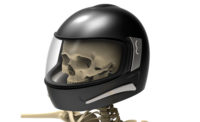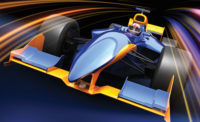I doubt many of you saw the finish of NASCAR’s Coke Zero 400 race at Daytona International Speedway, which due to a three-and-one-half hour rain delay ended at 2:41 a.m. Monday morning, July 6th. More likely you saw the highlight, if you can call it that, on ESPN, which probably showed it a hundred times.
Just after crossing the finish line in seventh place, racer Austin Dillon’s #3 Chevrolet SS, roaring home at 200 MPH in a tight pack of stock cars inches away from each other, got caught up in a collision of two cars in front of him. In the huge chain reaction crash that followed, Dillon’s car went airborne, sailing almost upside-down over two cars and smashing into a 22-foot high catch fence, which like a slingshot sent Dillon’s 3,200-pound car flying back across the track, landing on its roof. Then another car that couldn’t slow down smashed into Dillon’s wreckage. His smoldering engine block lay on the track yards away.
“Oh my God,” winning driver Dale Earnhardt Jr. yelled into his radio when he saw the flying race car in his rear view mirror. “I’m shocked that Austin Dillon is even alive from what he went through,” said Jimmie Johnson, who finished second. He wasn’t alone. Fans thought he was dead.
Fans at risk
Dillon slid out of what was left of his car and walked away, waving to the crowd. He suffered a bruised tailbone and forearm. (A week later he’d be racing in Kentucky.) Debris from the crash rained down on fans sitting behind the mangled catch fence. One was sent to a local hospital in stable condition. Four were treated and released by track medics, and a handful of others declined treatment. Several years ago another car catapulted into the catch fence at a Daytona race, injuring 28 fans and sending 14 to the hospital.
“It’s really not acceptable,” said Dillon after being released from the track’s medical treatment center. An understatement if ever there was one.
A day later, Dillon was asked on a NASCAR TV show if he would now be an advocate for safety. Which led me to wonder, why does safety need advocates? In U.S. industry, more than 4,000 workers are killed every year on the job. Hundreds of thousands are injured. Isn’t the need for safeguards rather obvious?
Ah, no it isn’t. On the same TV show, racing fans were asked what safety improvements should be made after Dillon’s near miss: slow the cars down, move the fans further away from the track, replace fencing with Plexiglas, or make no changes. Sixty percent voted for no change.
“I’m sorry fans,” said one of the commentators. “Sometimes you just have to do the thinking for people. Changes need to be made.”
Keeping coffers full
But super-fast racing is NASCAR’s ticket to huge crowds and profits. Slowing down “the product” is akin to slowing assembly lines in industry to make them safer. You’re biting the hand that fills the coffers. Create a bigger buffer between fans and the track? Die-hard fans will tell you they love to get close to the action, the smell of gasoline, the ear-splitting noise, a little tire rubber behind the ears. What business wants to risk irritating its customers? The problem with Plexiglas fencing is that it gets spray-painted with debris during a race, blocking fans’ view. “They might as well go home and watch it on TV,” said one analyst.
At the end of the day, or a long, hair-raising night at Daytona, safety needs advocates because it’s basically a reform movement – trying to change dangerous practices and attitudes. Any reform movement’s success hinges on persistent activists and advocates, hell-raisers, whistleblowers and muckrakers. The history of workplace safety in the U.S. would be a different tale if Upton Sinclair had not written “The Jungle.” If Alice Hamilton didn’t investigate occupational illnesses. If Tony Mazzocchi hadn’t become convinced industrial chemicals were hurting workers on the job and held town meetings around the nation for union members and environmentalists that accelerated the occupational safety movement and led to President Nixon signing into law the Occupational Safety and Health Act.
The weight of baggage
Safety requires advocacy in workplaces and construction sites large and small because safety carries baggage – the perception that it’s something for softies and do-gooders. NASCAR has to deal with safety measures being resisted by fans – and many drivers – as turning the sport into something for wussies. “It’s a tough sport and it’s what racing is about,” says driver Jeff Gordon. “We’re going to make mistakes. It’s just going to happen sometimes. They are freak incidents,” says Denny Hamlin, another racer. Even Austin Dillon said after his crash, “It is just part of racing.”
“Accidents will happen” is the equivalent mindset in industry. Money, the need for profits, take-home pay, and pleasing customers – be it getting products to market as fast as you can or racing stock cars as fast as they’ll go -- drive this business-as-usual, shrug-of-the-shoulders attitude about safety. Changing it, reforming it, takes nerve, salesmanship, diplomacy, negotiation, patience, politicking – advocacy.




